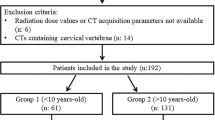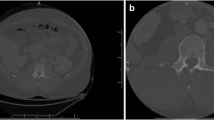Abstract
The purpose of this study is to determine how often CT is repeated to obtain chest/abdomen/pelvis data outside the reconstructed field of view (FOV) on a prior spine CT. Radiology records of 1,239 consecutive thoracic and lumbar spine CT exams of 1,025 patients from January 1, 2006 to December 31, 2008 were retrospectively reviewed to identify patients who subsequently had CT studies of the chest, abdomen, and/or pelvis. The CT data were also evaluated for contrast enhancement, slice thickness, radiation dose, and reason for subsequent CT exam. Over 3 years, 290 of the 1,239 (24%) spine CT exams were followed by CT of the same anatomic region to evaluate extraspinal anatomy. The use or nonuse of contrast in these follow-up studies was the same as the preceding spine study in 91 cases, which were repeated on the same day (n = 37), within 7 days (n = 19), within 8–30 days (n = 15), or after 30 days (n = 20). Fourteen of 25 (56%) T spine CTs and 34 of 52 (65%) L spine CTs without contrast were followed by a chest CT or abdomen/pelvis CT without contrast within 7 days, respectively. Among 31 pediatric exams, 6 of 31 (19%) spine CTs were followed by a CT of the same anatomic region, all within 7 days. Reconstructing full FOV images of spine CT scans in addition to the standard coned down spine FOV may reduce redundant CT imaging and radiation dose.
Similar content being viewed by others
References
Mettler FAJ et al (2000) CT scanning: patterns of use and dose. J Radiol Prot 20:353–359
Wiest PW et al (2002) CT scanning: a major source of radiation exposure. Semin Ultrasound CT MR 23(5):402–410
de Jong PA et al (2006) Estimation of cancer mortality associated with repetitive computed tomography scanning. Am J Respir Crit Care Med 173(2):199–203
Brenner D et al (2001) Estimated risks of radiation-induced fatal cancer from pediatric CT. AJR Am J Roentgenol 176(2):289–296
Brenner DJ, Hall EJ (2007) Computed tomography—an increasing source of radiation exposure. N Engl J Med 357:2277–2284
Hunold P et al (2001) Prevalence and clinical significance of accidental findings in electron-beam tomographic scans for coronary artery calcification. Eur Heart J 22:1748–1758
Haller S et al (2006) Coronary artery imaging with contrast-enhanced MDCT: extracardiac findings. Am J Roentgenol 187:105–110
Horton KM et al (2002) Prevalence of significant noncardiac findings on electron-beam computed tomography coronary artery calcium screening examinations. Circulation 106:532–534
White CS (2011) The pros and cons of searching for extracardiac findings at cardiac CT: use of a restricted field of view is acceptable. Radiology 261(2):338–341
McCollough C et al. (2008) The Measurement, reporting and management of radiation dose in CT. In AAPM report No. 96, A.A.o.P.i. Medicine, Editor. College Park
Budoff MJ, Gopal A (2007) Incidental findings on cardiac computed tomography. Should we look? J Cardiovasc Comput Tomogr 1(2):97–105
Budoff MJ, Fischer H, Gopal A (2006) Incidental findings with cardiac CT evaluation: should we read beyond the heart? Catheter Cardiovasc Interv 68(6):965–973
Budoff MJ (2009) Ethical issues related to lung nodules on cardiac CT. Am J Roentgenol 192:146
Frager DH et al (1986) Extraspinal abnormalities identified on lumbar spine CT. Neuroradiology 28:58–60
Northam M, Koonce J, Ravenel JG (2007) Pulmonary nodules detected at cardiac CT: comparison of images in limited and full fields of view. AJR Am J Roentgenol 191:878–881
Sosnouski D et al (2007) Extracardiac findings at cardiac CT: a practical approach. J Thorac Imaging 22:77–85
Kern KA (1994) Medicolegal analysis of the delayed diagnosis of cancer in 338 cases in the United States. Arch Surg 129(4):397–404
White CS, Salis AI, Meyer CA (1999) Missed lung cancer on chest radiography and computed tomography: imaging and medicolegal issues. J Thorac Imaging 14(1):63–68
MacMahon H, Austin JH, Gamsu G (2005) Guidelines for management of small pulmonary nodules detected on CT scans: a statement from the Fleischner Society. Radiology 237:395–400
Lee SI et al (2007) Does radiologist recommendation for follow-up with the same imaging modality contribute substantially to high-cost imaging volume? Radiology 242(3):857–864
Broder J, Fordham LA, Warshauer DM (2007) Increasing utilization of computed tomography in the pediatric emergency department, 2000–2006. Emerg Radiol 14:227–232
Lucey BC et al (2007) CT-guided intervention with low radiation dose: feasibility and experience. AJR Am J Roentgenol 188(5):1187–1194
Author information
Authors and Affiliations
Corresponding author
Rights and permissions
About this article
Cite this article
Newman, T.M., Cham, M.D., Zhang, H. et al. Clinical demand for chest/abdomen/pelvis anatomy following thoracic or lumbar spine CT. Emerg Radiol 19, 211–215 (2012). https://doi.org/10.1007/s10140-012-1028-1
Received:
Accepted:
Published:
Issue Date:
DOI: https://doi.org/10.1007/s10140-012-1028-1




